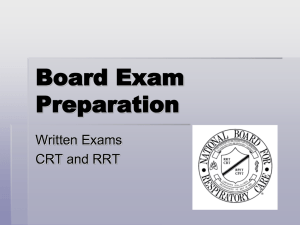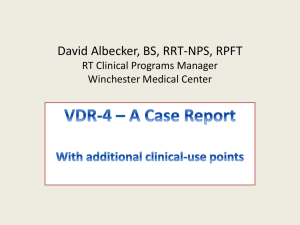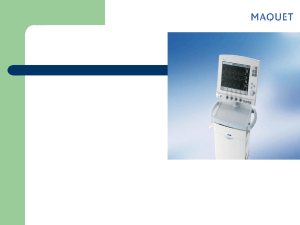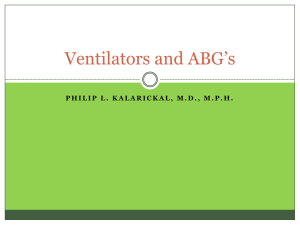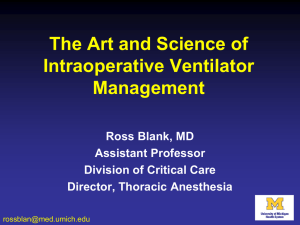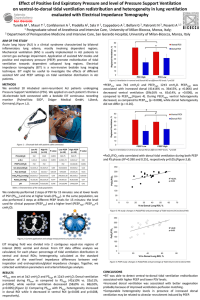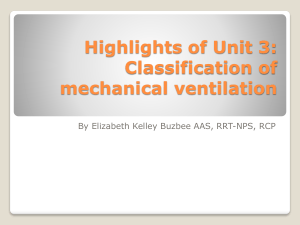PowerPoint Presentation - Respiratory Therapy Files
advertisement
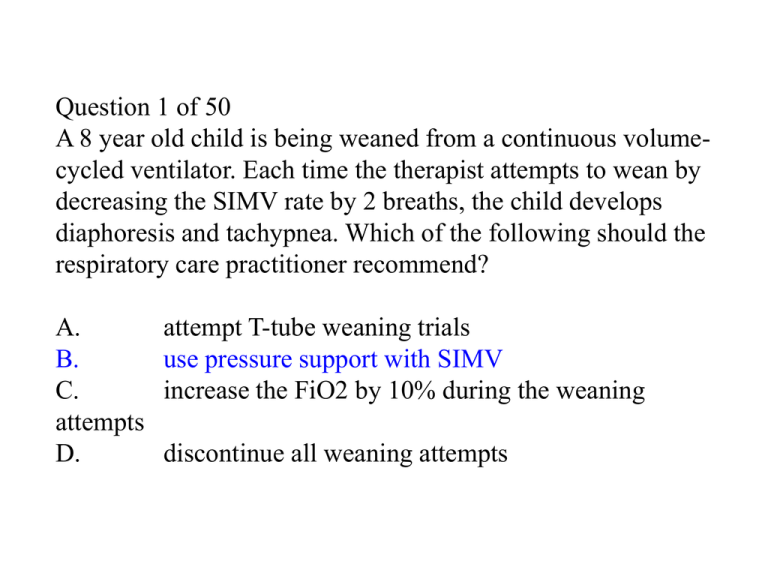
Question 1 of 50 A 8 year old child is being weaned from a continuous volumecycled ventilator. Each time the therapist attempts to wean by decreasing the SIMV rate by 2 breaths, the child develops diaphoresis and tachypnea. Which of the following should the respiratory care practitioner recommend? A. B. C. attempts D. attempt T-tube weaning trials use pressure support with SIMV increase the FiO2 by 10% during the weaning discontinue all weaning attempts Question 2 of 50 A 32 week gestational age infant is being mechanically ventilated with the following settings: FiO2 0.35 Rate 24 b/min. PEEP 10 cmH2O pressure PIP 25 cmH2O pressure Arterial blood gas results show: pH 7.39 PCO2 34 mmHg PO2 97 mmHg HCO3- 21 mEq/L Based upon the above information, the respiratory care practitioner should recommend: A. decreasing the PEEP B. decreasing the FiO2 C. decreasing the PIP D. increasing the rate Question 3 of 50 During a routine ventilator parameter check on a patient, you notice the low pressure alarm is being briefly activated prior to each breath. Which of the following is most likely the cause? A. B. C. D. the patient is fighting the ventilator the flow rate is set too fast the alarm delay is set too short the peak pressure limit is set too high Question 4 of 50 A 11 year old child weighing 45 kg (99 lbs) is being mechanically ventilated with a volume-cycled ventilator at the following settings: Mode SIMV Set Rate 10 br/min. Total Rate 12 br/min. VT 450 ml FiO2 0.60 PEEP 5 cmH2O Arterial blood gas results show: pH 7.35 PCO2 46 mmHg PO2 108 mmHg HCO3- 22 mEq/L Which of the following would you recommend at this time? A. B. C. D. increase SIMV to 12 decrease PEEP to 3 increase VT to 475 ml decrease FiO2 to 0.55 Question 5 of 50 The peak inspiratory pressure on a pressure limited, time-cycled ventilator was changed from 20 cmH2O pressure to 25 cmH2O pressure. Which of the following alarms need to be adjusted at this time? A. B. C. D. PEEP low pressure peak pressure I:E ratio Question 6 of 50 A 78 year old male patient is being treated for obstructive sleep apnea at night with bilevel positive airway pressure. Arterial blood gas results reveal an elevated PCO2 level. The respiratory care practitioner should recommend increasing the: A. B. C. D. oxygen concentration expiratory positive airway pressure (EPAP) inspiratory flow rate inspiratory positive airway pressure (IPAP) Question 7 of 50 A 3 year old child with cystic fibrosis is being mechanically ventilated by a time-cycled, pressure limited ventilator at the following settings: PIP 34 cmH2O I time 1.0 second Rate 22 br/min. FiO2 0.60 PEEP 6 cmH2O Mode SIMV Arterial blood gas results show: pH 7.36 PCO2 44 mmHg PO2 49 mmHg HCO3- 24 mEq/L The respiratory care practitioner should recommend adjusting the: A. B. C. D. PEEP to 8 cmH2O FiO2 to 0.65 Rate 24 br/min. Pressure 36 cmH2O Question 8 of 50 A 60 year old male patient weighs 80 kg (176 lbs) and is on a volume-cycled ventilator at a set VT of 800 ml, a peak pressure reading of 65 cmH2O, exhaled VT measured at 760 ml, peak inspiratory flowrate is 60 L/min., a plateau pressure reading of 58 cmH2O and a PEEP of 5 cmH2O. Which of the following is most likely occurring at this time? A. B. C. D. dynamic compliance is decreasing static compliance is increasing airway resistance is increasing thoracic compliance is increasing Question 9 of 50 A 79 year old female weighing 54 kg (119 lbs) is a post-operative total hip replacement patient who is receiving mechanical ventilation at the following settings: Mode A/C FiO2 0.45 Set rate 12 br/min. Total rate 18 br/min. VT 600 ml Arterial blood gas results show: pH 7.52 PCO2 29 mmHg PO2 91 mmHg HCO3- 23 mEq/L Which of the following would you recommend at this time? A. B. C. D. add 5 cmH2O PEEP therapy decrease VT to 550 ml initiate SIMV at 12 br/min. decrease FiO2 0.40 Question 10 of 50 A 75 kg (165 lbs) male patient is being mechanically ventilated following coronary artery bypass surgery. He is currently on the following settings: Mode SIMV Set rate 10 br/min. Total rate 14 br/min. FiO2 0.40 VT 750 ml PEEP 8 cmH2O Arterial blood gas results show: pH 7.41 PCO2 44 mmHg PO2 85 mmHg HCO3- 23 mEq/L You would recommend which of the following at this time? A. B. C. D. decrease the FiO2 decrease the rate to 8 increase the PEEP to 10 cmH2O maintain the current settings Question 11 of 50 A 28 week gestational age infant with severe respiratory distress syndrome is being mechanically ventilated with a time-cycled, pressure limited ventilator at the following settings: Flow rate 6 LPM Set rate 32 br/min. PIP 28 cmH2O FiO2 0.70 PEEP 5 cmH2O I time 0.8 seconds Umbilical arterial blood gas results reveal: pH 7.40 PCO2 39 mmHg PO2 42 mmHg HCO3- 23mEq/L Based on the above information, the respiratory care practitioner should recommend which of the following? A. B. C. D. I time to 1.0 seconds PEEP to 7cmH2O FiO2 to 0.75 PIP to 30 cmH2O Question 12 of 50 A 45 year old female patient who weighs 60 kg (132 lbs) remains intubated in the recovery room after an exploratory laparoscopy. She is currently receiving 6 cmH2O of CPAP with an FiO2 of 0.35 for the past 2 hours. Arterial blood gases and vital signs are stable with the following information obtained: RR MIP VT VC 16 br/min. -36 cmH2O 400 ml 1.2 L Based upon the above information, the respiratory care practitioner should recommend: A. B. C. D. maintain the current therapy decrease the CPAP to 4 cmH2O extubate and monitor the patient obtain a portable chest x-ray Question 13 of 50 Which of the following will decrease the mean airway pressure on a patient receiving continuous volume-cycled ventilation? A. B. C. D. decrease the inspiratory time decrease the peak flowrate decrease the expiratory time decrease the triggering effort Question 14 of 50 A 19 year old male patient weighing 78 kg (172 lbs) was brought into the ER with a suspected drug overdose. He is now intubated and being mechanically ventilated with a volume-cycled ventilator at the following settings: Mode A/C Set rate 12 br/min. Total rate 12 br/min. VT 850 ml FiO2 0.50 Peak flow 30 LPM The physician notes the ratio light is flashing and has asked the respiratory care practitioner to make the appropriate adjustment. You would do which of the following: A. B. C. D. increase the flow decrease the tidal volume to 800 ml decrease the FiO2 increase the sensitivity Question 15 of 50 A 10 year old child with muscular dystrophy is on a chest cuirass at a -10 cmH2O pressure, at a rate of 12 br/min. with the following arterial blood gases: pH 7.34 PCO2 52 mmHg PO2 58 mmHg HCO3- 26 mEq/L Which of the following would you recommend? A. B. C. D. switch to a volume-cycled ventilator increase the rate to 14 br/min. change the pressure to -15 cmH2O switch to a pressure-cycled ventilator Question 16 of 50 A 58 year old, 65 kg (143 lbs) women arrives to the surgical ICU following aortic adbominal aneurysm repair surgery. She has 40 pack year history of cigarette smoking and is currently smoking 1 pack a day. The physician has writtten an order to initiate mechanical ventilation. All of the following controls need to be adjusted by the respiratory care practitioner prior to starting mechanical ventilation for this patient, EXCEPT: A. B. C. D. FiO2 VT f PEEP Question 17 of 50 Which of the following is NOT an indication for continuous positive airway pressure? A. B. C. D. a Qs/Qt of < 15% PaO2 < 50 mmHg on an FiO2 > 0.60 a spontaneously breathing patient an increased A-a DO2 gradient Question 18 of 50 A spontaneously breathing 76 year old patient who weighs 60 kg (132 lbs) is on a FiO2 of 0.45 via a trach collar has had a change in their tidal volume from 600 ml to 300 ml and their respiratory rate went from 12 br/min. to 24 br/min.. Which of the following changed due to the change in the tidal volume and rate? A. B. C. D. minute ventilation alveolar ventilation anatomical deadspace mechanical deadspace Question 19 of 50 During an incentive spirometry treatment using a volume orientated device, the patient inhales to TLC and exhales slowly to FRC what other instructions would you give to improve distribution? A. B. C. D. continue with the current instructions switch to a flow orientated device initiate IPPB inspiratory hold Question 20 of 50 A 75 kg (165 lbs) patient is receiving volume-cycled mechanical ventilation, the respiratory care practitioner notes the following: Mode SIMV Set rate 12 br/min. Total rate 16 br/min. FiO2 0.35 VT 700 ml The arterial blood gases are as follows: pH 7.28 PCO2 53 mmHg PO2 79 mmHg HCO3- 24 mEq/L Which of the following would you recommend at this time? A. B. C. D. increase the FiO2 to 0.40 add 5 cmH2O PEEP increase VT to 750 ml increase SIMV to 14 br/min. Question 21 of 50 A 15 year old female patient who weighs 55 kg (121 lbs) has multiple trauma from a four wheeler accident and has developed ARDS. The respiratory care practitoner notes the following data: Mode SIMV Set rate 12 br/min. Total rate 14 br/min. FiO2 0.60 PEEP 10 cmH2O VT 600 ml The arterial blood gases are as follows: pH 7.34 PCO2 38 mmHg PO2 79 mmHg HCO3- 21 mEq/L The patient becomes agitated and is using accessory muscles and is attempting to pull out the IV lines. Which of the following would you recommend at this time? A. B. C. D. switch to assist/control mode curare pavulon versed Question 22 of 50 A 70 kg (154 lbs) post-cardiopulmonary arrest patient is on a volume-cycled ventilator in the assist/control mode. The respiratory care practitioner notes the following data: Set rate 8 br/min. Total rate 8 br/min. FiO2 0.65 VT 850 ml The arterial blood gas results are as follows: pH 7.30 PCO2 56 mmHg PO2 78 mmHg HCO3- 21 mEq/L Which of the following ventilator adjustments would you recommend first? A. B. C. D. institute PEEP therapy at 5 cmH2O increase the rate to 12 br/min. increase the FiO2 to 0.70 increase the VT to 900 ml Question 23 of 50 A 62 year old patient weighing 50 kg (110 lbs) with a history of emphysema is on a volume-cycled ventilator due to acute respiratory failure. The respiratory care practitioner notes the following: Mode SIMV Set rate 6 br/min. Total rate 16 br/min. VT 600 ml FiO2 0.28 Arterial blood gases are as follows: pH 7.37 PCO2 56 mmHg PO2 65 mmHg HCO3- 32 mEq/L Which of the following would you recommend? A. B. C. D. increase the SIMV to 8 br/min. increase the FiO2 to 0.30 maintain the current settings increase the VT to 650 ml Question 24 of 50 Which of the following pathologies would be LEAST appropriate for pressure-cycled ventilation? A. B. C. D. kyphosis muscular dystrophy chronic CO2 retainer drug overdose Question 25 of 50 A 12 year old female weighing 40 kg (88 lb) is receiving continuous mechanical ventilation following an accidental drug overdose. The respiratory care practitoner notes the following: Mode SIMV Set rate 12 br/min. Total rate 12 br/min. VT 750 ml FiO2 0.30 Arterial blood gases are as follows: pH 7.58 PCO2 23 mmHg PO2 141 mmHg HCO3- 22 mEq/L Which of the following would you recommend? A. B. C. D. decrease the tidal volume decrease the respiratory rate decrease the FiO2 add mechanical deadspace Question 26 of 50 Which of the following parameters are acceptable for weaning a patient from continuous mechanical ventilation? I. VD/VT 65% II. MIP -18 cmH2O III. Qs/Qt 10% IV. A-aDO2 12 mmHg (21% oxygen) A. B. C. D. III & IV only I & II only I, II & III only I, II, III & IV Question 27 of 50 During an incentive spirometry treatment using a flow device, the float will not rise during inspiration. This may be due to all of the following, EXCEPT: A. B. C. D. a crack in the casing an obstructed mouthpiece inspiratory effort is too strong inspiratory flow is too slow Question 28 of 50 Which of the following can help decrease auto PEEP for a patient who is receiving continuous mechanical ventilation? I. increase the flow II. change from a decelerating wave to a constant square wave III. add expiratory retard IV. add inspiratory hold A. B. C. D. I & III only II & IV only I, II & III only I, II, III & IV Question 29 of 50 A 39 year old male weighing 85 kg (187 lbs) is on a volume-cycled ventilator following mitral valve replacement surgery. Ventilator settings are as follows: FiO2 0.45 Set rate 12 br/min. Total rate 22 br/min. VT 900 ml Flow rate 30 LPM Mode SIMV The patient appears to be agitated and restless. The physician asks for your recommendation. You would recommend which of the following? A. B. C. D. switch to pressure support ventilation switch to pressure control ventilation administer Versed increase the flow Question 30 of 50 A 46 year old female patient weighing 65 kg (143 lbs) is on a volume-cycled ventilator following a motor vehicle accident. Ventilator settings are as follows: FiO2 0.40 Mode SIMV Set rate 6 br/min. Total rate 16 br/min. VT 700 ml Pressure support 25 cmH2O Arterial blood gas results are as follows: pH 7.51 PCO2 29 mmHg PO2 140 mmHg HCO3- 22 mEq/L Based upon the above information, you would recommend which of the following at this time? A. B. C. D. decrease pressure support to 20 cmH2O decrease FiO2 to 0.30 place on a T-tube at 50% oxygen decrease SIMV to 3 br/min. Question 31 of 50 A 52-year-old 5 ft, 9 in. tall male patient weighs 85 kg (187 lb) is being mechanically ventilated. An arterial blood gas has been obtained. Ventilatory data and blood gas results are below: Mode Assist/Control FIO2 0.40 Mandatory rate 10 Total rate 10 VT 650 mL PEEP 5 cm H2O Mechanical VD 100 mL pH 7.28 PaCO2 74 torr PaO2 57 torr SaO2 86% HCO3 23 mEq/L BE 0 mEq/L Which of the following changes should be recommended at this time? A. B. C. D. Decrease the VT to 550 mL Decrease the mandatory rate to 8 Decrease the mechanical deadspace Decrease the FIO2 to 0.35 Question 32 of 50 A 75 kg (165 lb) patient with a sub-arachnoid hemorrhage is being mechanically ventilated with a volumecontrolled ventilator at the following settings Mode Assist control VT 700 mL Mandatory rate 12 Total rate 12 FIO2 .40 PEEP 0 I:E Ratio 1:2 Arterial Blood Gas analysis reveals the following pH 7.35 PaCO2 41 torr PaO2 85 torr HCO3- 23 mEq/L SaO2 94% The respiratory therapist should recommend A. B. C. D. increase the tidal volume decrease the respiratory rate increase the FIO2 add inflation hold Question 33 of 50 A 52-year-old 5 ft, 9 in. tall male patient weighs 85 kg (187 lb) is being mechanically ventilated. An arterial blood gas has been obtained. Ventilatory data and blood gas results are below: Mode Assist/Control FIO2 0.40 Mandatory rate 16 Total rate 16 VT 850 mL PEEP 5 cm H2O pH 7.47 PaCO2 31 torr PaO2 87 torr SaO2 96% HCO3 23 mEq/L BE 0 mEq/L Which of the following changes should be recommended at this time? A. B. C. D. Decrease the rate to 12 Decrease the VT to 600 mL Increase the FIO2 to 0.45 Increase the PEEP to 8 cm H2O Question 34 of 50 A 34-year-old male patient is 5 ft, 10 in. tall and weighs 81 kg (178 lb). He has suffered multiple trauma in an automobile accident and is being mechanically ventilated. Chest radiograph reveals diffuse infiltrates with reticulogranular formation. An arterial blood gas has been obtained. Ventilatory data and blood gas results are below: Mode SIMV FIO2 0.60 Mandatory rate 10 VT 700 mL PIP 38 cm H2O Plateau pressure 29 cm H2O PEEP 10 cm H2O pH 7.37 PaCO2 45 torr PaO2 51 torr SaO2 82% HCO3 23 mEq/L BE 0 mEq/L Which of the following changes should be recommended at this time? A. B. C. D. Increase the PEEP to 30 cm H2O Increase the VT to 800 mL Increase the mandatory rate to 16 Change the mode to control, sedate as necessary Question 35 of 50 A 52-year-old 6 ft, 1 in. tall male patient weighs 85 kg (187 lb) is being mechanically ventilated. An arterial blood gas has been obtained. Ventilatory data and blood gas results are below: Mode Assist/Control FIO2 0.40 Mandatory rate 10 Total rate 10 VT 850 mL PEEP 10 cm H2O pH 7.49 PaCO2 28 torr PaO2 87 torr SaO2 96% HCO3 25 mEq/L BE +1 mEq/L Which of the following changes should be recommended at this time? A. B. C. D. Decrease the rate to 5 Decrease the VT to 450 mL Increase the PEEP to 15 cm H2O Add 50 mL of mechanical deadspace Question 36 of 50 A patient who is 5 ft, 8 in. tall and weighs 68 kg (150 lb) is being mechanically ventilated. Chest radiograph reveals bilateral infiltrates. An arterial blood gas has been obtained. Ventilatory data and blood gas results are below: Mode SIMV FIO2 0.50 Mandatory rate 10 Total rate 20 VT 700 mL Spontaneous VT 250 mL PIP 26 cm H2O Plateau pressure 20 cm H2O PEEP 5 cm H2O pH 7.47 PaCO2 31 torr PaO2 97 torr SaO2 96% HCO3 23 mEq/L BE 0 mEq/L Which of the following changes should be recommended at this time? A. B. C. D. Increase the PEEP to 15 cm H2O Increase the VT to 900 mL Increase the mandatory rate to 16 Maintain current settings Question 37 of 50 A 80 kg (176 lb) patient with pulmonary fibrosis is being mechanically ventilated with a volume-controlled ventilator at the following settings Mode SIMV VT 700 mL Mandatory rate 15 Total rate 15 FIO2 0.45 PEEP +10 I:E Ratio 1:2 PIP 50 cmH2O Arterial Blood Gas analysis reveals the following pH 7.34 PaCO2 42 torr PaO2 55 torr HCO3- 22 mEq/L SaO2 88% The respiratory therapist should recommend: A. B. C. D. increasing the FIO2 to 60%. decreasing the respiratory rate. increase the PEEP level to 20 cm H2O. changing to pressure control mode. Question 38 of 50 A 68 kg (150 lb) patient with left lower lobe pneumonia is being mechanically ventilated with a volume-controlled ventilator at the following settings Mode Assist control VT 800 mL Mandatory rate 12 Total rate 12 FIO2 0.55 PEEP +5 I:E Ratio 1:3 PIP 45 cmH2O Arterial Blood Gas analysis reveals the following pH 7.33 PaCO2 42 torr PaO2 65 torr HCO3- 21 mEq/L SaO2 90% The respiratory therapist should recommend: A. B. C. D. increasing the tidal volume. decreasing the respiratory rate. increase the PEEP level. changing to pressure control mode. Question 39 of 50 A patient who is 5 ft, 8 in. tall and weighs 68 kg (150 lb) is being mechanically ventilated. Chest radiograph reveals bilateral infiltrates. An arterial blood gas has been obtained. Ventilatory data and blood gas results are below: Mode SIMV FIO2 0.50 Mandatory rate 10 Total rate 20 VT 700 mL Spontaneous VT 250 mL PEEP 5 cm H2O pH 7.42 PaCO2 41 torr PaO2 67 torr SaO2 89% HCO3 24 mEq/L BE 0 mEq/L Which of the following changes should be recommended at this time? A. Change to pressure control ventilation at 35 cm H2O B. Change to inverse ratio ventilation, sedate as necessary C. Initiate pressure support ventilation at 10 cm H2O D. Maintain current settings Question 40 of 50 The respiratory therapist reviews the ventilator flow sheet for a post-op patient. The ventilator settings have not been changed during the past 24 hours. The peak and plateau pressures were recorded as above. This information would indicate: A. B. C. D. Airway resistance is increasing Lung compliance is decreasing The patient can begin weaning The PEEP should be increased Question 41 of 50 The respiratory therapist reviews the ventilator flow sheet for a post-op patient. The ventilator settings have not changed during the past 24 hours. The peak and plateau pressures were recorded as above. This information would indicate: A. B. C. D. Airway resistance is increasing Lung compliance is decreasing The patient needs to be suctioning The patient can begin weaning Question 42 of 50 The respiratory therapist reviews the ventilator flow sheet for a post-op patient. The ventilator settings have not been changed during the past 24 hours. The peak and plateau pressures were recorded as above. This information would indicate: A. B. C. D. Airway resistance is increasing Lung compliance is increasing The patient can begin weaning The PEEP should be increased Question 43 of 50 A 65 kg (143 lb) patient with a sub-arachnoid hemorrhage is being mechanically ventilated with a volumecontrolled ventilator at the following settings Mode SIMV VT 800 mL Mandatory rate Total rate 12 FIO2 0.40 PEEP 0 I:E Ratio 1:2 12 Arterial Blood Gas analysis reveals the following pH 7.35 PaCO2 41 torr PaO2 85 torr HCO3- 23 mEq/L SaO2 94% The respiratory therapist should recommend A. B. C. D. decreasing the tidal volume increasing the respiratory rate adding 5 cmH2O of PEEP maintaining current settings Question 44 of 50 A 57-year-old male patient with severe left-sided pneumonia is being mechanically ventilated. The chest radiograph shows left side consolidation with air bronchograms. An arterial blood gas has been obtained. Ventilatory data and blood gas results are below: Mode Assist/Control FIO2 0.80 Mandatory rate 20 Total rate 20 VT 650 mL PIP 30 cm H2O Plateau Pressure 25 cm H2O PEEP 15 cm H2O pH 7.38 PaCO2 43 torr PaO2 52 torr HCO3 24 mEq/L BE 0 mEq/L Which of the following should the therapist recommend? A. B. C. D. Increase the FIO2 to 1.0 Decrease the PEEP to 10 cm H2O Increase the VT to 800 mL Decrease the mandatory rate to 15 Question 45 of 50 A 20-year-old, 90 kg (198 lb) man is receiving mechanical ventilation. The chest radiograph shows diffuse irregular infiltrates. Pertinent data are below: Mode SIMV Mandatory rate 10 Total rate 20 VT 0.5 L FIO2 0.60 PEEP 5 cm H2O Peak flow 65 L/min I:E ratio 1:2 pH 7.37 PaCO2 48 torr PaO2 79 torr SaO2 92% HCO3 23 mEq/L BE 0 mEq/L The therapist should recommend A. B. C. D. Decrease the mandatory rate Increase the tidal volume Decrease the FIO2 Decrease the peak flow Question 46 of 50 A patient has come to the pulmonary function lab for pre-op testing. The patient performs a maximum inspiration followed by a maximum forceful expiration. This procedure would measure: A. B. C. D. RV FRC TLC FVC Question 47 of 50 A patient complaining of dyspnea has the following arterial blood gas results: pH - 7.36 PaCO2 - 56 torr PaO2 - 49 torr HCO3 - 34 mEq/L SaO2 - 80% FIO2 - .21 These results are best described as: A. B. C. D. acute respiratory acidosis acute metabolic alkalosis chronic respiratory acidosis chronic metabolic alkalosis Question 48 of 50 A patient involved in an automobile accident is receiving continuous IV fluids in the intensive care unit. Which of the following could indicate that a fluid overload is present? I. fine rales II. fluffy infiltrates III. peripheral edema A. B. C. D. I and II only II and III only I and III only I, II and III Question 49 of 50 What would the therapist palpate when assessing a patient with a tension pneumothorax? A. B. C. D. hyperresonance tracheal deviation absent breath sounds increased work of breathing Question 50 of 50 A patient is receiving non-invasive positive pressure assisted ventilation (NIPPV) with a Bi-level positive airway pressure ventilator at the following settings. IPAP - 25 cmH2O EPAP - 5 cmH2O rate - 10 br/min Arterial blood gas results are: pH - 7.49 PaCO2 - 29 torr PaO2 - 110 torr HCO3- - 25 mEq/L SaO2 - 98% Which of the following should the therapist recommend? A. B. C. D. increase the IPAP decrease the IPAP increase the EPAP decrease the EPAP

